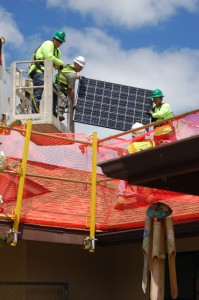3 noteworthy solar installations

I receive so many pitches about new residential and commercial solar installations that it is really tough to write about all of them. But I wanted to highlight three that have caught my attention this month, because I think they are indicative of broader trends in the solar market.

#1: Hawaii military community goes solar
Construction began in mid-July on one of the largest solar installations in Hawaii, a 4-megawatt installation by SolarCity that will power more than 2,000 military homes in Honolulu.
The installation at Hickam Communities, at the Joint Base Pearl Harbor-Hickam, is expected to produce 5.6 million kilowatt-hours of electricity annually. The installation will be underway for approximately two years, creating about 50 green jobs in the area.
The project will initially target 600 rooftops on building managed by Lend Lease, which is the property management company for Hickam Air Force Base through 2057. Those rooftops will produce enough power for the entire community. Lend Lease and SolarCity negotiated a 20-year power purchase agreement to finance the project, which is part of the Department of Defense's plan to handle at least 25 percent of its energy requirements with renewable energy sources by 2025.
Eventually, the Hickam site will be the second largest solar-powered community on an Air Force base. The biggest one is at Soaring Heights at the Davis-Monthan Air Force Base in Arizona.
I'm sensing that a focus by property management companies on outfitting their properties with solar might be a continued focus by the larger installers and management companies like SolarCity.
 #2: U.S. Foodservice switches on another major installation
#2: U.S. Foodservice switches on another major installation
Distributor U.S. Foodservice in Los Angeles has switched on another major commercial solar installation, a 1.15-megawatt system that is on one of its warehouses.
There are close to 5,000 photovoltaic panels that make up the rooftop installation. The project is expected to produce up to 1.6 million kilowatt-hours of electricity annually, which is about 16 percent of the facility's energy needs.
The technology is being leased from Del Solar.
Commercial installations such as this one continue to hit my inbox, especially giving the broader variety of funding options becoming available to businesses in certain states.
 #3: Don't forget the pool, when installing residential solar
#3: Don't forget the pool, when installing residential solar
Although I doubt my neighbors here in Northern New Jersey have their pool heaters on this week (it's 100 degrees here right now), they do run them often during the summer. So I sat up and took notice when I chatted with California homeowner Chris Crocker about his new solar installation. That's because not only has Crocker invested in enough panels to run his home, he also opted to install some that support running the pool behind his 3,800-square-foot house.
When I spoke with Crocker, he said that he didn't originally think about including his pool when planning his installation. But his installer from ABC Solar pointed out that the payback for technology to keep his pool heated would actually be quicker than those for his house, about 2.5 years compared with the approximately 7.5 years that it will take to recoup the investment for his home. Overall, about 85 percent of Crocker's property's aggregate power needs are handled by the solar panels.
Crocker's installation includes 20 SunPower SPR225 solar panels, which provide excess power back into the grid during the daytime hours when the system generates more than the home needs. Four panels are associated with running the pump and solar thermal heating system for the pool. Previously, it cost almost $500 in electricity per month to heat the pool, so the math made sense, he said All of these technologies were installed on the back of the house facing southwest, so that they didn't detract from its curb appeal.
Crocker said his installation cost about $45,000, although he received some of that money back through a rebate program. "Solar is getting to a place now where it's not trendy, it's real," he said.
This post was originally published on Smartplanet.com